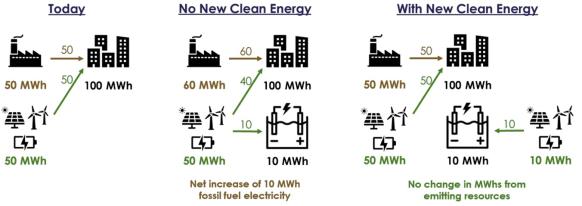US grapples with how clean is green hydrogen
The Inflation Reduction Act will help build a viable hydrogen economy, but its success in reducing emissions may depend on how the United States defines what counts as clean.

Related Articles
The IRA, passed last year, will plough almost $400 billion into clean energy projects and a large part of that will finance a tiered subsidy for emission-free hydrogen production.
The tax credits are expected to attract investment in the U.S. clean hydrogen industry at every stage of the process and from companies all over the world.
However, the plan has prompted concerns hydrogen production will ramp up faster than the addition of new, emission-free electricity, and the newly installed electrolyzers will absorb all available emissions-free power from renewables, nuclear, and hydro, leaving the country’s coal- and gas-fired plants to fill the void.
“The electrolysis process only makes sense if we're using completely renewable energy and we need to ensure that the effective energy being used by the grid for these projects is renewable,” says Pete Budden who leads the Natural Resources Defense Council’s (NRDC’s) state and regional-level hydrogen policy work.
“We can't allow these projects to incorrectly incentivize fossil fuel generators to increase their output on the grid to meet this need of electrolyzers.”
Illustrative Depiction of Importance of New Clean Energy
(Click to enlarge)
Source: Energy Innovation study "Smart Design of 45V Hydrogen Production Tax Credit will Reduce Emissions and Grow the Industry"
Dollars for green gas
Hydrogen can only be considered clean, and eligible for the subsidy, if it is accompanied by the installation of clean electricity, Budden says.
The IRA’s 45V Hydrogen Production Tax Credit (PTC) awards up to $3 per kilograms (kg) of hydrogen produced to projects with lifecycle greenhouse gas emission (GHG) intensity of less than 0.45 kg per kg of hydrogen.
The system has four tiers, depending on how much CO2 is produced in the production of the hydrogen, with the lowest offering $0.6/kg for GHG intensity of 2.5-4.0 kg per kg of hydrogen.
The question of tax credits is one for the U.S. Treasury, which must decide by August which activities will be eligible for which tier.
Until that is clear, developers are left waiting.
“The Treasury must develop a set of guidelines so that businesses know that if they do X, they get the credit. The promise of the IRA has been extremely helpful for the United States and has stimulated investments from overseas, but this incomplete guidance leaves for unfinished business,” says President and CEO of the Fuel Cell and Hydrogen Energy Association (FCHEA) Frank Wolak.
“The question is, how do you calculate and score the greenness of the highest tier?”
Determining the “greenness” of the hydrogen is a high stakes game for the industry, which is already laying plans to invest in electrolyzers, hydrogen hubs, pipelines, refueling stations, and other essential infrastructure, while also finding the right consumers that are ready to decarbonize their own supply lines.
Failure to qualify for the highest tier would undermine the economic viability of any green hydrogen project, says Wolak.
Defining guidelines
The guidelines for calculating the level of emissions rest on the ‘Three Pillars’: new supply, or additionality, deliverability, and hourly time-matching.
The stickiest point has been additionality, which stipulates that any electricity used for hydrogen production must be from new generating projects and not rest on the existing national grid.
Renewable energy accounted for just 20% of the U.S.’s electricity generation in 2021, according to the U.S. Energy Information Administration, while another 19% is from nuclear power. The remaining 61% is power generated by plants running on natural gas (38%), coal (22%) and petroleum (0.5%).
Today, 99% of U.S. hydrogen production of more than 10 million metric tons (MT) is from fossil fuels, with 95% from natural gas by steam methane reforming (SMR) and 4% from partial oxidation of natural gas via coal gasification.
The remaining 1% is from electrolysis.
Decarbonizing an industry
Hydrogen use is currently for industrial purposes, such as in the production of steel, and chemicals, such as fertilizers and ammonia, all of which must be decarbonized.
New markets for the gas will also include energy storage, and heavy-duty, long-haul trucks, and may even be extended to smaller industrial vehicles, aviation, and shipping.
According to the U.S. government’s ‘Hydrogen Shot’, which aims to bring green hydrogen prices down to $1/kg within one decade, there is an opportunity for at least a five-fold increase in clean hydrogen use.
With or without additionality, this would require a massive increase in domestic power generation.
Around 50 kWh is needed to produce one kilo of hydrogen, meaning the Hydrogen Shots’ goal of 50 MT of hydrogen a year by 2050 would need around 2,500 TWh to produce, on top of the nearly 4,000 TWh of power already used every year in the country, a 62.5% increase.
Interim targets aim for 10 MT a year capacity by 2030 and 20 MT by 2040.
For all that hydrogen to be green, the extra power must be generated from emission-free sources, including wind, solar, nuclear, and hydro.
When that extra capacity is installed is at the center of a growing battle between those that wish to immediately jump on the IRA subsidies and start producing discounted hydrogen and those that fear the national grid needs to be reinforced before the electrolyzers start running.
By Paul Day

